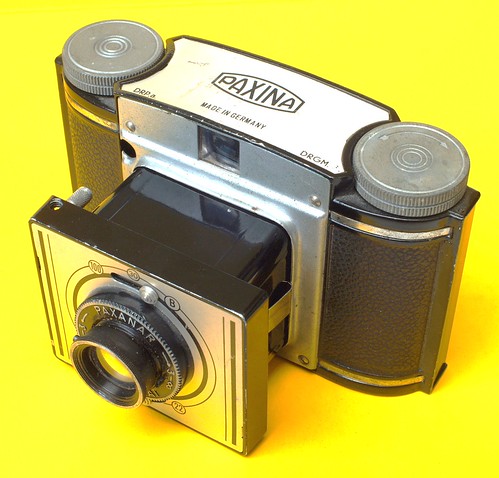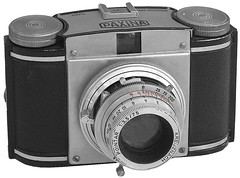Difference between revisions of "Braun Paxina"
(wikilink for achromat on simplest camera; added Pointar to list of lenses) |
(Rearranged pictures, made top one bigger.) |
||
| Line 1: | Line 1: | ||
| − | < | + | <div class="floatright plainlinks" style="margin:0px 0px 10px 15px;"> |
| − | {| | + | {{Flickr_image |
| − | | | + | |image_source= http://www.flickr.com/photos/89864432@N00/2578988148/in/pool-camerawiki |
| − | | | + | |image= http://farm4.static.flickr.com/3148/2578988148_bedbf6d2c4.jpg |
| + | |image_align= | ||
| + | |image_text= Paxina (I) with the square lens tube pulled out;<br/>Paxanar Achromat lens | ||
| + | |image_by=Uwe Kulick | ||
| + | |image_rights=with permission | ||
| + | }} | ||
| + | </div> | ||
| + | <div class="floatright plainlinks" style="margin:0px 0px 10px 15px;"> | ||
{{Flickr_image | {{Flickr_image | ||
|image_source= http://www.flickr.com/photos/alf_sigaro/286698091/in/pool-camerawiki | |image_source= http://www.flickr.com/photos/alf_sigaro/286698091/in/pool-camerawiki | ||
|image= http://farm1.static.flickr.com/116/286698091_1e251f7455_m.jpg | |image= http://farm1.static.flickr.com/116/286698091_1e251f7455_m.jpg | ||
|image_align= right | |image_align= right | ||
| − | |image_text= | + | |image_text= Paxina II (lens tube collapsed);<br/>75mm f/3.5 [[Roeschlein-Kreuznach|Roeschlein]] Pointar lens<br/>and [[Vario]] shutter. |
|image_by=Alf Sigaro | |image_by=Alf Sigaro | ||
|image_rights=with permission | |image_rights=with permission | ||
}} | }} | ||
| − | |||
{{Flickr_image | {{Flickr_image | ||
|image_source= http://www.flickr.com/photos/awcam/2298192797/in/pool-camerawiki | |image_source= http://www.flickr.com/photos/awcam/2298192797/in/pool-camerawiki | ||
|image= http://farm4.static.flickr.com/3220/2298192797_8c17812500.jpg | |image= http://farm4.static.flickr.com/3220/2298192797_8c17812500.jpg | ||
|image_align= right | |image_align= right | ||
| − | |image_text= A battered | + | |image_text= A battered Paxina II; 70mm f/3.5<br/>Pointar lens, extended; [[Vario]] shutter. |
|image_by=AWCam | |image_by=AWCam | ||
|image_rights=with permission | |image_rights=with permission | ||
}} | }} | ||
| − | + | </div> | |
| − | |||
| − | |||
| − | |||
| − | |||
| − | |||
| − | |||
| − | |||
| − | |||
| − | |||
| − | </ | ||
'''Paxina''' is a line of medium-format [[viewfinder camera]]s for 6×6 cm exposures on ([[120 film|120]] film, made by the [[Braun]] company in Nuremberg, Germany in the middle part of the 20th century. | '''Paxina''' is a line of medium-format [[viewfinder camera]]s for 6×6 cm exposures on ([[120 film|120]] film, made by the [[Braun]] company in Nuremberg, Germany in the middle part of the 20th century. | ||
Revision as of 13:56, 26 August 2011

|
| Paxina (I) with the square lens tube pulled out; Paxanar Achromat lens image by Uwe Kulick (Image rights) |

|
| Paxina II (lens tube collapsed); 75mm f/3.5 Roeschlein Pointar lens and Vario shutter. image by Alf Sigaro (Image rights) |

|
| A battered Paxina II; 70mm f/3.5 Pointar lens, extended; Vario shutter. image by AWCam (Image rights) |
Paxina is a line of medium-format viewfinder cameras for 6×6 cm exposures on (120 film, made by the Braun company in Nuremberg, Germany in the middle part of the 20th century.
Contents
Paxina (I)
The first Paxina model (numbered I only retrospectively, because of the existence of the model II) was made in 1950-54.[1] It is very similar to Braun's earlier Pax (the only significant difference being the basic focusing control). The lens is a Paxanar 75 mm f/7.7 achromat; it has three aperture settings (f/7.7, f/11 and f/22). It has very coarse zone focusing, with one marking for 1-3 metres and another for 3 m - infinity. The everset shutter has speeds 1/100 and 1/30 second, plus 'B'. The shutter release is hidden behind the lens panel, which pulls out from the camera on a square lens tube; springs on each side pop out to keep the tube out, and straight. The viewfinder is a reverse Galilean one, built into the body.
Paxina II
The Paxina II was made from 1951-57,[1] and offered alongside the original model. It still has a collapsing lens tube, but this is round. Several different lens and shutter combinations were offered during the period of production (McKeown lists the camera as four sub-models, II, IIa, IIb and IIc, according to the lens). Some of the options represents a distinct step up in specification from the previous model.
Lenses (all 75 mm) include an f/3.5 Kataplast or f/3.5 Kata by Staeble, an f/3.5 Pointar (by Roeschlein, but labelled only Kreuznach), an f/3.5 or f/6.3 Steinar by Steiner, an f/3.5, f/6.3 or f/8 Praxar and a Pranar (of unspecified aperture but similar in size to the f/8 Praxar). Shutters with the better lenses include the Pronto, Vario or even Prontor SVS; the better of these have a cable release socket and even a self-timer; other models have a simple shutter with 'I' and 'B' exposure (but synchronised, with a PC socket).
The camera has a cold shoe on the top plate, and a slightly deeper film winding knob than the previous model; otherwise it is similar.
Paxina 29
The Paxina 29 was made from 1953.[1] It has the fastest lenses of the series, and f/2.9 Praxar or Steinar, in a Pronto or Prontor SVS shutter.
The line was continued with a model for 4×4 cm pictures on 127 film, the Paxina Electromatic.
- ↑ 1.0 1.1 1.2 McKeown, James M. and Joan C. McKeown's Price Guide to Antique and Classic Cameras, 12th Edition, 2005-2006. USA, Centennial Photo Service, 2004. ISBN 0-931838-40-1 (hardcover). ISBN 0-931838-41-X (softcover). p155-6.
Links
Andrys Stienstra's collection site.
- Braun Paxina I, Braun Paxina II on www.collection-appareils.fr by Sylvain Halgand